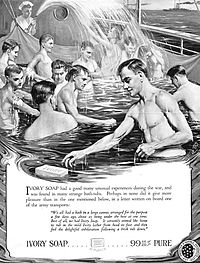Sex in advertising
This article possibly contains original research. (September 2007) |
This article needs additional citations for verification. (February 2007) |
Sex in advertising is the use of sexual attraction as a tool of persuasion to draw interest to a particular product, for purpose of sale. Nudity, cheesecake, and beefcake in advertising often fall in this category, even if it is often only suggestively so.
History


Over the past two decades, the use of increasingly explicit sexual appeals in consumer-oriented print advertising has become almost commonplace. Sexuality is considered one of the most powerful tools of marketing and particularly advertising[citation needed]. Post-advertising sales response studies have shown it can be very effective for attracting immediate interest, holding that interest, and, in the context of that interest, introducing a product that somehow correlates with that interest.
Further evidence comes from Gallup & Robinson, an advertising and marketing research firm which reports that in more than 50 years of testing advertising effectiveness, it has found the use of the erotic to be a significantly above-average technique in communicating with the marketplace, "...although one of the more dangerous for the advertiser. Weighted down with taboos and volatile attitudes, sex is a Code Red advertising technique ... handle with care ... seller beware; all of which makes it even more intriguing." This research has led to the popular idea that "sex sells".
The use of sex in advertising can be highly overt or extremely subtle: from relatively explicit displays of sexual acts, down to the use of basic cosmetics to enhance attractive features.
Criticism
Use of sexual imagery in advertising has been criticized on different grounds. Conservatives, especially religious ones, often consider it obscene. Some feminists feel it objectifies women (as women are more often portrayed in a sexual manner than men[citation needed]). Similarly, some masculists feel that it objectifies men. Some claim it reinforces sexism.
Increasingly, this argument has been complicated by growing awareness of androgynous and homoerotic themes used in marketing. Calvin Klein has been at the forefront of this movement, having himself declared, "Jeans are about sex. The abundance of bare flesh is the last gasp of advertisers trying to give redundant products a new identity."
In recent years ads for jeans, perfumes[1] and many other products have featured provocative images that were designed to elicit sexual responses from as large a cross section of the population as possible, to shock by their ambivalence, or to appeal to repressed sexual desires, which are thought to carry a stronger emotional load. Increased tolerance, more tempered censorship, emancipatory developments and increasing buying power of previously neglected appreciative target groups in rich markets (mainly in the west) have led to a marked increase in the share of attractive flesh 'on display'.
See also
- Advertising
- Cosmetic advertising
- Jean Kilbourne
- Marketing
- Nudity in art
- Promotion
- Sex in film
- Sexploitation
References
External links
- Sexuality in the Mass Media: How to View the Media Critically
- Sexuality, Contraception, and the Media
- Early use of a homoerotic symbol in advertising: Budweiser beer ad based on Zeus' abduction of Ganymede
- History of erotic advertising.
- Sexual Messages in Ads & Other Media
- Gallup & Robinson: Sex in Advertising
- The Gender Ads Project
